2019 Ram ProMaster City Snow tires
[x] Cancel search: Snow tiresPage 99 of 348

3. Snow or ice around the wheels or wheel housings.
4. Using tire chains on the vehicle.
5. Using wheels/tires not equipped with TPM sensors.
NOTE:Your vehicle can be equipped with either Tire
Service Kit, compact spare tire or regular size spare tire
(with or without original TPMS sensor).
1. Tire Service Kit (original tire sealant – if equipped): After fixing the punctured tire with original tire sealant, the
original situation will be restored, so system will turn off
the telltale during the normal drive.
2. Compact Spare Tire – if equipped: The compact spare wheel is not equipped with TPMS sensor. So when
mounted, during the normal drive the system will turn
on the telltale (flashing for approximately 75 sec. then
remains solid). This condition persists until a wheel
equipped with original TPMS sensor has been mounted
on the vehicle.
3. Regular size spare tire (not equipped with TPMS sen- sor): When mounted, during the normal drive the
system will turn on the telltale (flashing for approxi-
mately 75 sec. then remains solid). This condition per-
sists until a wheel equipped with original TPMS sensor has been mounted on the vehicle. Then the system will
be restored and the telltale will turn off during the
normal drive.
4. Regular size spare tire (equipped with TPMS sensor): When mounted, the telltale will turn off during the
normal drive.
5. In all the above cases please check the replacement tire inflation pressure before driving your vehicle.
6. In case of tire replacement, if the vehicle is driven for short periods of time, then the system can take a while
to be restored.
NOTE: For a correct Tire Pressure Monitoring behavior,
please wait for about 20 minutes in key-off during each tire
substitution.
General Information
This device complies with Part 15 of the FCC rules and RSS
210 of Industry Canada. Operation is subject to the follow-
ing conditions:
1. This device may not cause harmful interference.
2. This device must accept any interference received, in- cluding interference that may cause undesired opera-
tion.
5
SAFETY 97
Page 188 of 348

DRIVING TIPS
Driving On Slippery Surfaces
Acceleration
Rapid acceleration on snow covered, wet, or other slippery
surfaces may cause the driving wheels to pull erratically to
the right or left. This phenomenon occurs when there is a
difference in the surface traction under the front (driving)
wheels.
WARNING!
Rapid acceleration on slippery surfaces is dangerous.
Unequal traction can cause sudden pulling of the front
wheels. You could lose control of the vehicle and
possibly have a collision. Accelerate slowly and care-
fully whenever there is likely to be poor traction (ice,
snow, wet, mud, loose sand, etc.).
Traction
When driving on wet or slushy roads, it is possible for a
wedge of water to build up between the tire and road
surface. This is hydroplaning and may cause partial or
complete loss of vehicle control and stopping ability. Toreduce this possibility, the following precautions should be
observed:
•
Slow down during rainstorms or when the roads are
slushy.
• Slow down if the road has standing water or puddles.
• Replace the tires when tread wear indicators first be-
come visible.
• Keep tires properly inflated.
• Maintain sufficient distance between your vehicle and
the vehicle in front of you to avoid a collision in a
sudden stop.
Driving Through Water
Driving through water more than a few inches/centimeters
deep will require extra caution to ensure safety and pre-
vent damage to your vehicle.
Flowing/Rising Water
WARNING!
Do not drive on or across a road or path where water is
flowing and/or rising (as in storm run-off). Flowing
(Continued)
186 STARTING AND OPERATING
Page 271 of 348

description (Load Index and Speed Symbol). Replace the
tire pressure sensor as well as it is not designed to be
reused.
Run Flat Tires — If Equipped
Run Flat tires allow you the capability to drive 50 miles
(80 km) at 50 mph (80 km/h) after a rapid loss of inflation
pressure. This rapid loss of inflation is referred to as the
Run Flat mode. A Run Flat mode occurs when the tire
inflation pressure is of/or below 14 psi (96 kPa). Once a
Run Flat tire reaches the run flat mode it has limited
driving capabilities and needs to be replaced immediately.
A Run Flat tire is not repairable. When a run flat tire is
changed after driving with underinflated tire condition,
please replace the TPM sensor as it is not designed to be
reused when driven under run flat mode (14 psi (96 kPa))
condition.
NOTE:TPM Sensor must be replaced after driving the
vehicle on a flat tire condition.
It is not recommended driving a vehicle loaded at full
capacity or to tow a trailer while a tire is in the run flat
mode.
See the tire pressure monitoring section for more informa-
tion.
Tire Spinning
When stuck in mud, sand, snow, or ice conditions, do not
spin your vehicle’s wheels above 30 mph (48 km/h) or for
longer than 30 seconds continuously without stopping.
Refer to “Freeing A Stuck Vehicle” in “In Case Of Emer-
gency” for further information.
WARNING!
Fast spinning tires can be dangerous. Forces generated
by excessive wheel speeds may cause tire damage or
failure. A tire could explode and injure someone. Do
not spin your vehicle’s wheels faster than 30 mph
(48 km/h) for more than 30 seconds continuously when
you are stuck, and do not let anyone near a spinning
wheel, no matter what the speed.
Tread Wear Indicators
Tread wear indicators are in the original equipment tires to
help you in determining when your tires should be re-
placed.
8
SERVICING AND MAINTENANCE 269
Page 274 of 348
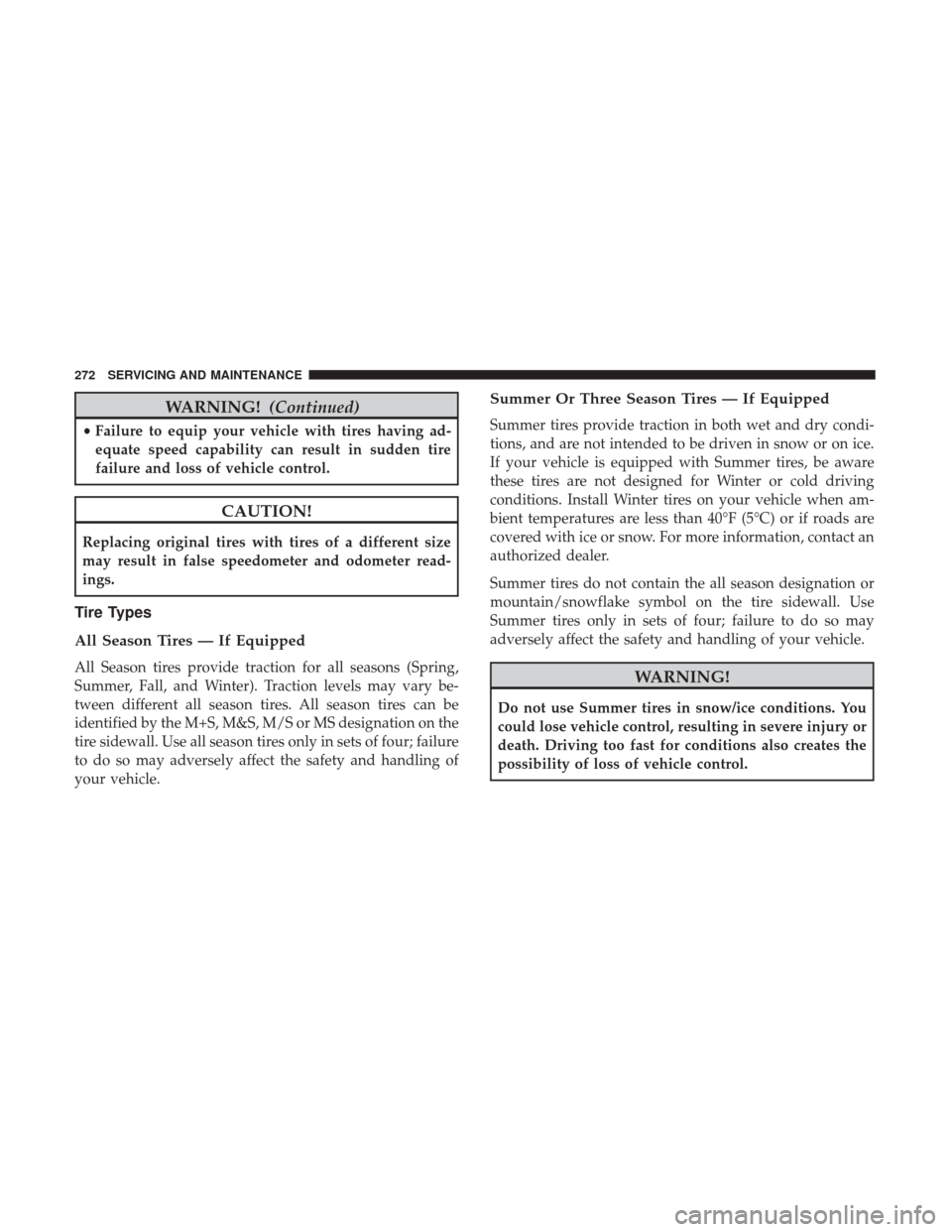
WARNING!(Continued)
•Failure to equip your vehicle with tires having ad-
equate speed capability can result in sudden tire
failure and loss of vehicle control.
CAUTION!
Replacing original tires with tires of a different size
may result in false speedometer and odometer read-
ings.
Tire Types
All Season Tires — If Equipped
All Season tires provide traction for all seasons (Spring,
Summer, Fall, and Winter). Traction levels may vary be-
tween different all season tires. All season tires can be
identified by the M+S, M&S, M/S or MS designation on the
tire sidewall. Use all season tires only in sets of four; failure
to do so may adversely affect the safety and handling of
your vehicle.
Summer Or Three Season Tires — If Equipped
Summer tires provide traction in both wet and dry condi-
tions, and are not intended to be driven in snow or on ice.
If your vehicle is equipped with Summer tires, be aware
these tires are not designed for Winter or cold driving
conditions. Install Winter tires on your vehicle when am-
bient temperatures are less than 40°F (5°C) or if roads are
covered with ice or snow. For more information, contact an
authorized dealer.
Summer tires do not contain the all season designation or
mountain/snowflake symbol on the tire sidewall. Use
Summer tires only in sets of four; failure to do so may
adversely affect the safety and handling of your vehicle.
WARNING!
Do not use Summer tires in snow/ice conditions. You
could lose vehicle control, resulting in severe injury or
death. Driving too fast for conditions also creates the
possibility of loss of vehicle control.
272 SERVICING AND MAINTENANCE
Page 275 of 348
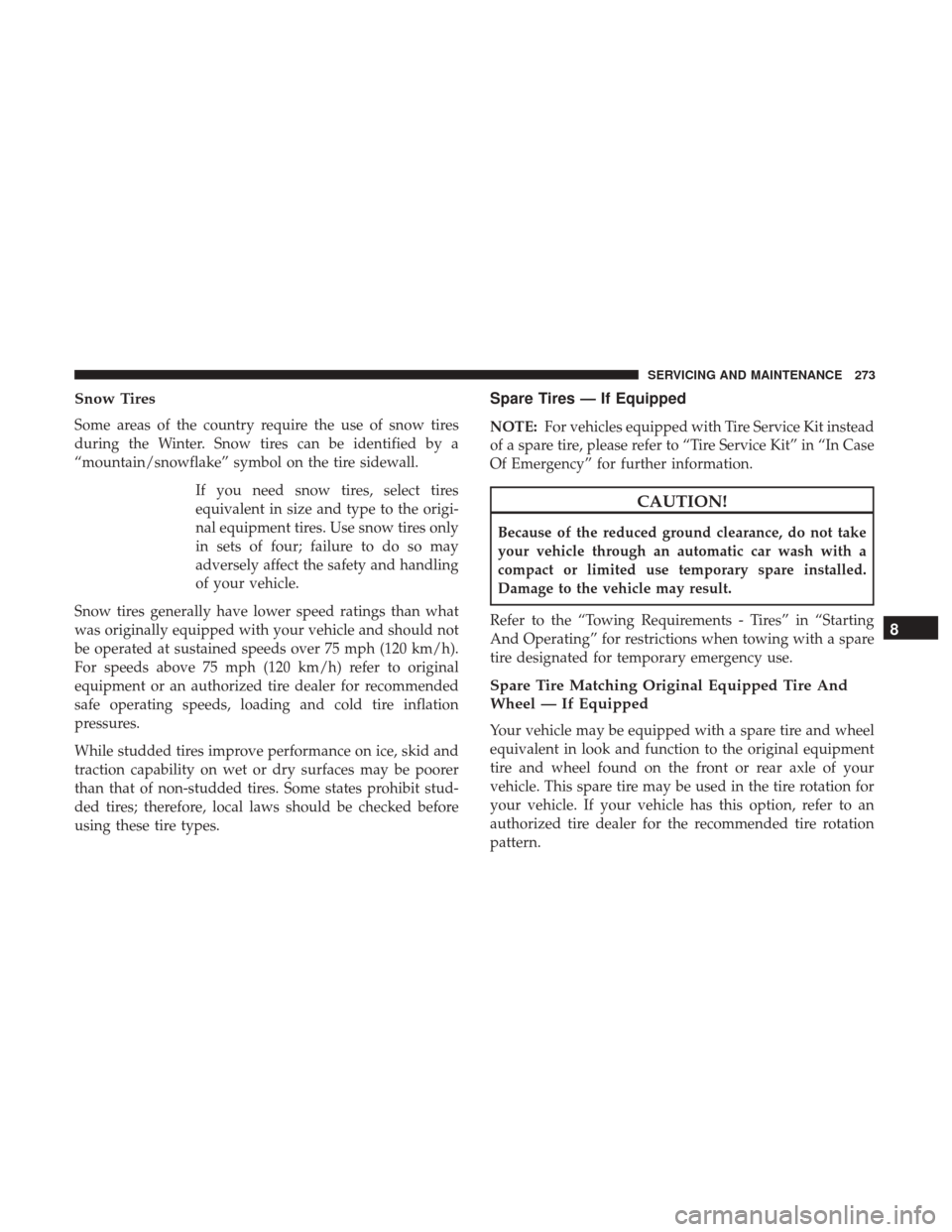
Snow Tires
Some areas of the country require the use of snow tires
during the Winter. Snow tires can be identified by a
“mountain/snowflake” symbol on the tire sidewall.If you need snow tires, select tires
equivalent in size and type to the origi-
nal equipment tires. Use snow tires only
in sets of four; failure to do so may
adversely affect the safety and handling
of your vehicle.
Snow tires generally have lower speed ratings than what
was originally equipped with your vehicle and should not
be operated at sustained speeds over 75 mph (120 km/h).
For speeds above 75 mph (120 km/h) refer to original
equipment or an authorized tire dealer for recommended
safe operating speeds, loading and cold tire inflation
pressures.
While studded tires improve performance on ice, skid and
traction capability on wet or dry surfaces may be poorer
than that of non-studded tires. Some states prohibit stud-
ded tires; therefore, local laws should be checked before
using these tire types.
Spare Tires — If Equipped
NOTE: For vehicles equipped with Tire Service Kit instead
of a spare tire, please refer to “Tire Service Kit” in “In Case
Of Emergency” for further information.
CAUTION!
Because of the reduced ground clearance, do not take
your vehicle through an automatic car wash with a
compact or limited use temporary spare installed.
Damage to the vehicle may result.
Refer to the “Towing Requirements - Tires” in “Starting
And Operating” for restrictions when towing with a spare
tire designated for temporary emergency use.
Spare Tire Matching Original Equipped Tire And
Wheel — If Equipped
Your vehicle may be equipped with a spare tire and wheel
equivalent in look and function to the original equipment
tire and wheel found on the front or rear axle of your
vehicle. This spare tire may be used in the tire rotation for
your vehicle. If your vehicle has this option, refer to an
authorized tire dealer for the recommended tire rotation
pattern.
8
SERVICING AND MAINTENANCE 273
Page 279 of 348
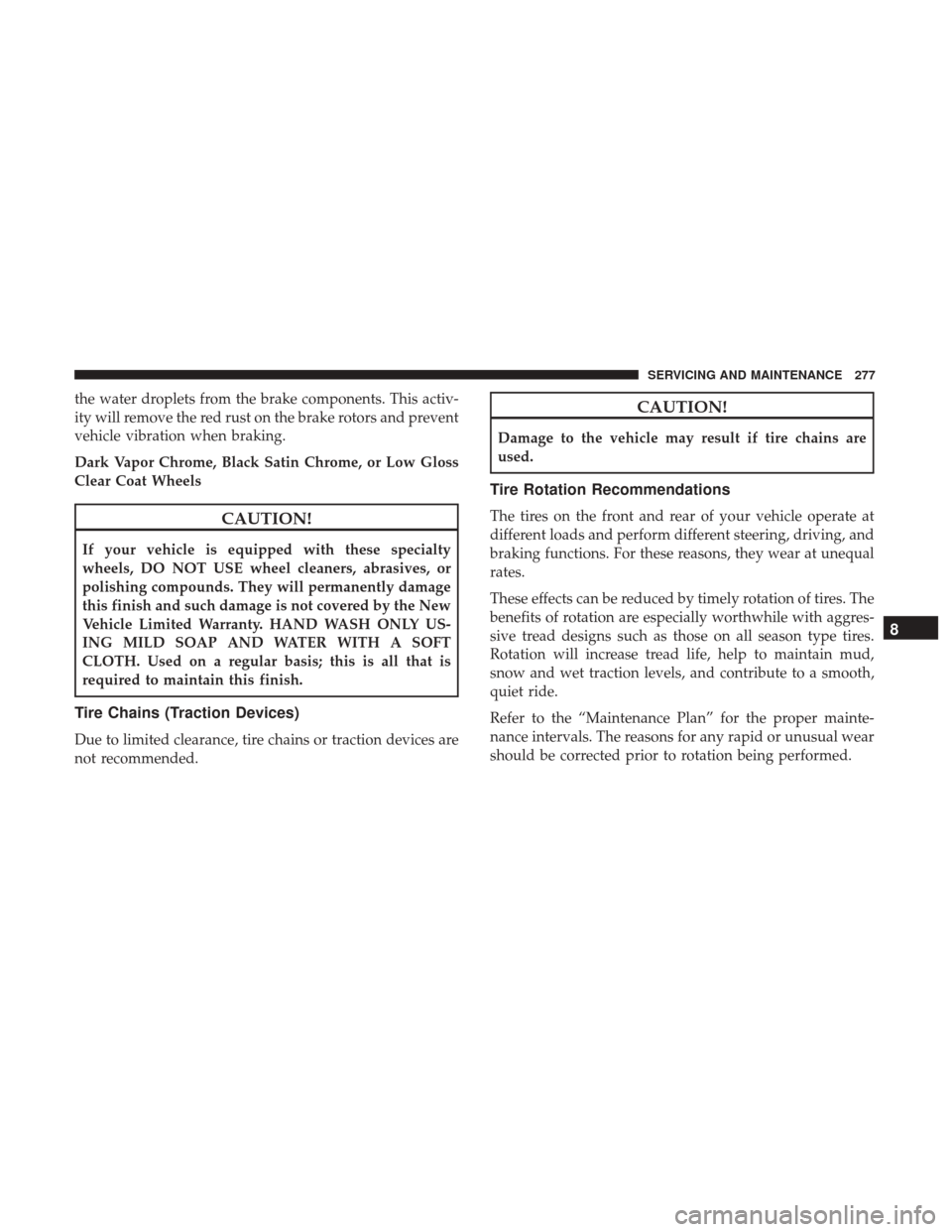
the water droplets from the brake components. This activ-
ity will remove the red rust on the brake rotors and prevent
vehicle vibration when braking.
Dark Vapor Chrome, Black Satin Chrome, or Low Gloss
Clear Coat Wheels
CAUTION!
If your vehicle is equipped with these specialty
wheels, DO NOT USE wheel cleaners, abrasives, or
polishing compounds. They will permanently damage
this finish and such damage is not covered by the New
Vehicle Limited Warranty. HAND WASH ONLY US-
ING MILD SOAP AND WATER WITH A SOFT
CLOTH. Used on a regular basis; this is all that is
required to maintain this finish.
Tire Chains (Traction Devices)
Due to limited clearance, tire chains or traction devices are
not recommended.
CAUTION!
Damage to the vehicle may result if tire chains are
used.
Tire Rotation Recommendations
The tires on the front and rear of your vehicle operate at
different loads and perform different steering, driving, and
braking functions. For these reasons, they wear at unequal
rates.
These effects can be reduced by timely rotation of tires. The
benefits of rotation are especially worthwhile with aggres-
sive tread designs such as those on all season type tires.
Rotation will increase tread life, help to maintain mud,
snow and wet traction levels, and contribute to a smooth,
quiet ride.
Refer to the “Maintenance Plan” for the proper mainte-
nance intervals. The reasons for any rapid or unusual wear
should be corrected prior to rotation being performed.
8
SERVICING AND MAINTENANCE 277
Page 336 of 348
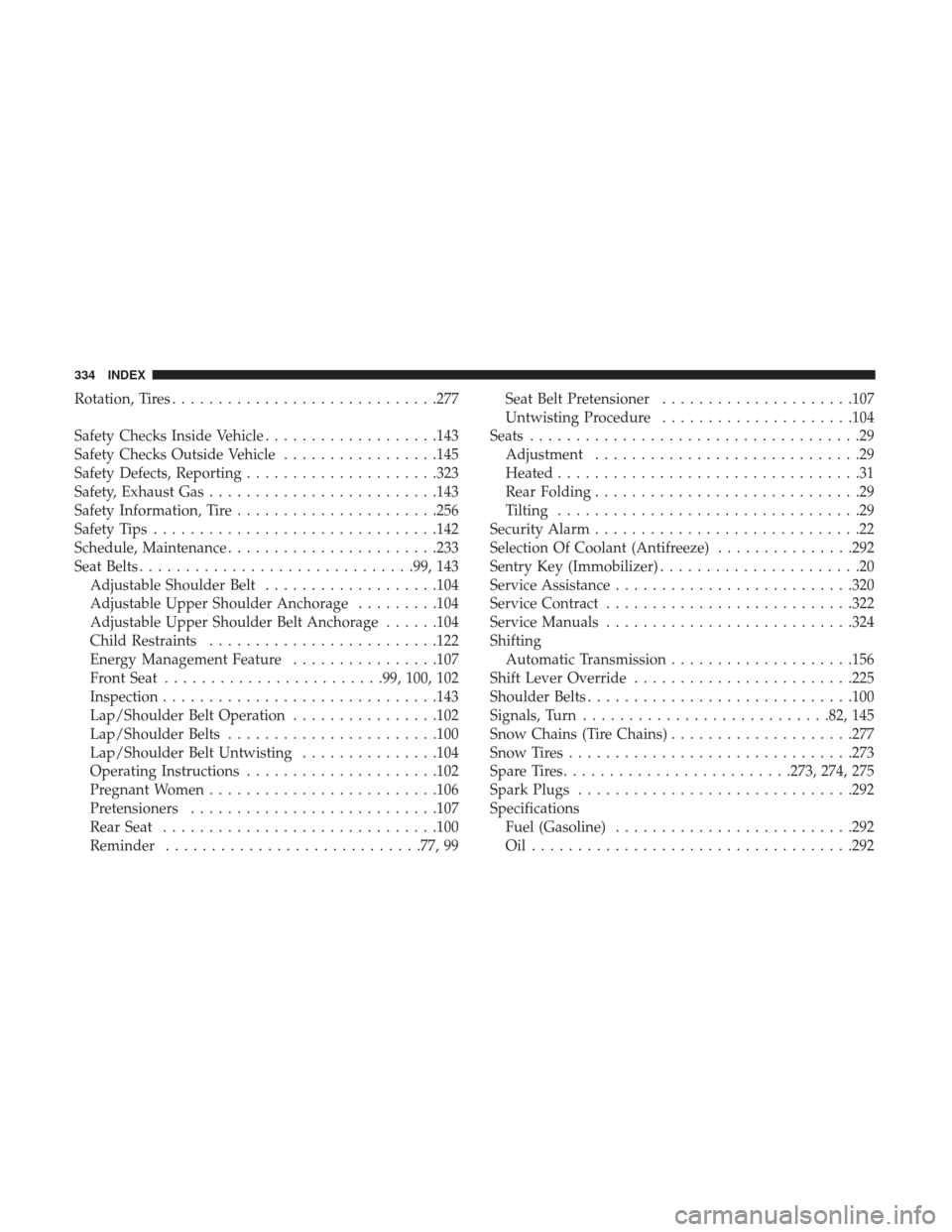
Rotation, Tires............................ .277
Safety Checks Inside Vehicle ...................143
Safety Checks Outside Vehicle .................145
Safety Defects, Reporting .....................323
Safety, Exhaust Gas ........................ .143
Safety Information, Tire ..................... .256
Safety Tips .............................. .142
Schedule, Maintenance ...................... .233
Seat Belts ............................. .99, 143
Adjustable Shoulder Belt ...................104
Adjustable Upper Shoulder Anchorage .........104
Adjustable Upper Shoulder Belt Anchorage ......104
Child Restraints ........................ .122
Energy Management Feature ................107
Front Seat ....................... .99, 100, 102
Inspection ............................. .143
Lap/Shoulder Belt Operation ................102
Lap/Shoulder Belts ...................... .100
Lap/Shoulder Belt Untwisting ...............104
Operating Instructions .....................102
Pregnant Women ........................ .106
Pretensioners .......................... .107
Rear Seat ............................. .100
Reminder ........................... .77, 99Seat Belt Pretensioner
.....................107
Untwisting Procedure .....................104
Seats ....................................29
Adjustment .............................29
Heated .................................31
Rear Folding .............................29
Tilting .................................29
Security Alarm .............................22
Selection Of Coolant (Antifreeze) ...............292
Sentry Key (Immobilizer) ......................20
Service Assistance ......................... .320
Service Contract .......................... .322
Service Manuals .......................... .324
Shifting Automatic
Transmission ....................156
Shift Lever Override ....................... .225
Shoulder Belts ............................ .100
Signals, Turn .......................... .82, 145
Snow Chains (Tire Chains) ....................277
Snow Tires .............................. .273
Spare Tires ........................ .273, 274, 275
Spark Plugs ............................. .292
Specifications Fuel (Gasoline) ......................... .292
Oil.................................. .292
334 INDEX
Page 337 of 348
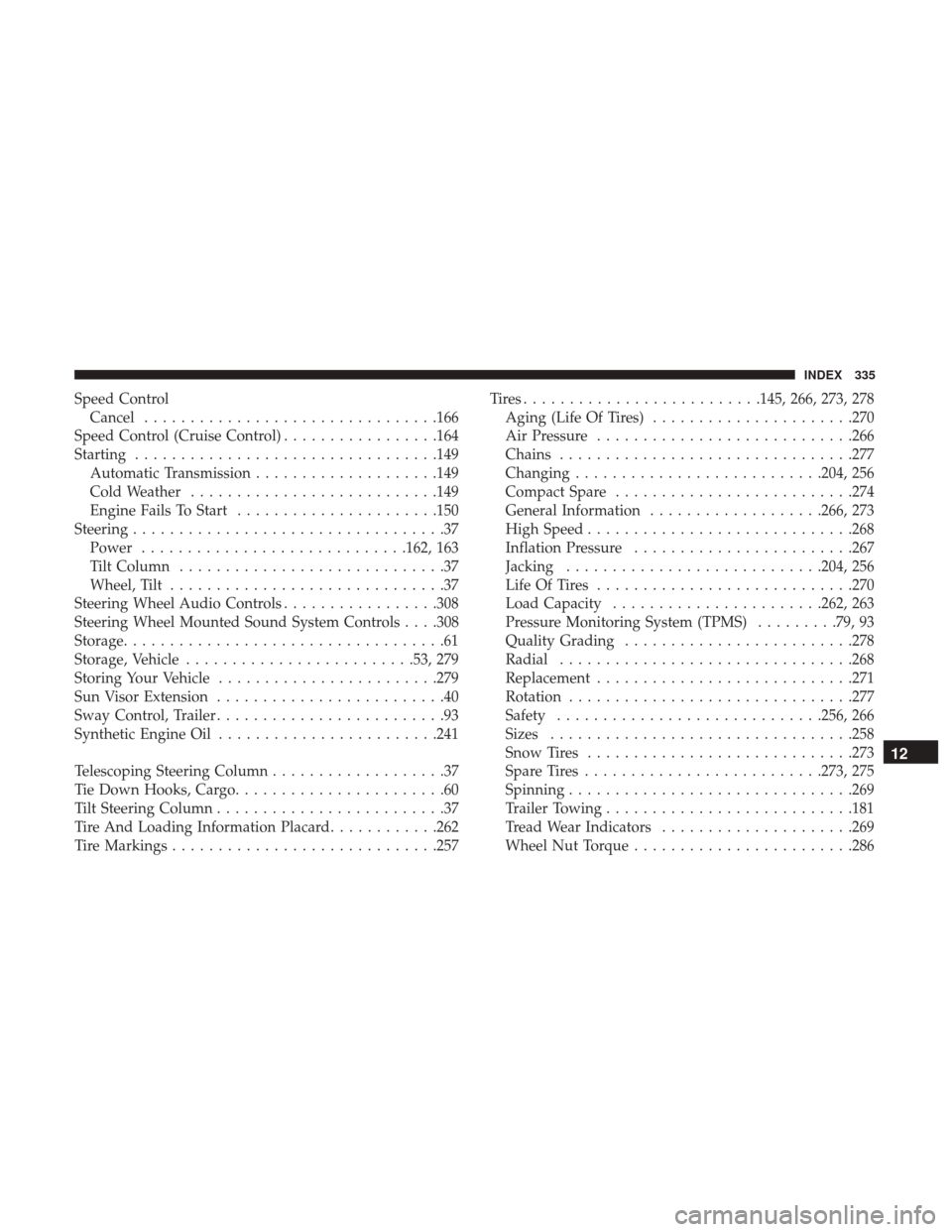
Speed ControlCancel ............................... .166
Speed Control (Cruise Control) .................164
Starting ................................ .149
Automatic Transmission ....................149
Cold Weather .......................... .149
Engine Fails To Start ..................... .150
Steering ..................................37
Power ............................ .162, 163
Tilt Column .............................37
Wheel, Tilt ..............................37
Steering Wheel Audio Controls .................308
Steering Wheel Mounted Sound System Controls . . . .308
Storage ...................................61
Storage, Vehicle ........................ .53, 279
Storing Your Vehicle ....................... .279
Sun Visor Extension .........................40
Sway Control, Trailer .........................93
Synthetic Engine Oil ....................... .241
Telescoping Steering Column ...................37
Tie Down Hooks, Cargo .......................60
Tilt Steering Column .........................37
Tire And Loading Information Placard ............262
Tire Markings ............................ .257Tires.........................
.145, 266, 273, 278
Aging (Life Of Tires) ..................... .270
Air Pressure ........................... .266
Chains ............................... .277
Changing .......................... .204, 256
Compact Spare ......................... .274
General Information ...................266, 273
High Speed ............................ .268
Inflation Pressure ....................... .267
Jacking ........................... .204, 256
Life Of Tires ........................... .270
Load Capacity ...................... .262, 263
Pressure Monitoring System (TPMS) .........79, 93
Quality Grading ........................ .278
Radial ............................... .268
Replacement ........................... .271
Rotation .............................. .277
Safety ............................ .256,
266
Sizes ................................ .258
Snow Tires ............................ .273
Spare Tires ......................... .273, 275
Spinning .............................. .269
Trailer Towing .......................... .181
Tread Wear Indicators .....................269
Wheel Nut Torque ....................... .286
12
INDEX 335